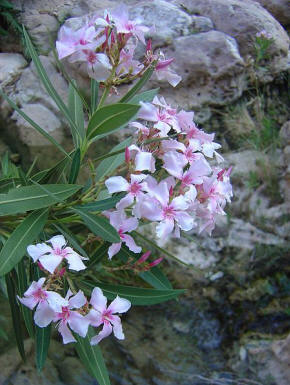Nerium oleander: Not a Nice Treat to Eat!
 Nerium
oleander is one of the most interesting organisms on the
face of the planet! It can be found throughout the world
in many warm habitats. This
plant is often used as an ornamental plant in many gardens and
road medians because it is very resistant to many different
plant killers such as predators,
drought, and
poor soil.
Nerium
oleander is one of the most interesting organisms on the
face of the planet! It can be found throughout the world
in many warm habitats. This
plant is often used as an ornamental plant in many gardens and
road medians because it is very resistant to many different
plant killers such as predators,
drought, and
poor soil.
This plant is also very easy to spot. It can vary in
height but it is usually between 6 and 12 feet tall and 6 to
10 feet wide. It can have many different kinds of flowers
but the most common are pink, white, and red. These flowers grow
in groups of 5. It also has very long, narrow, leathery
leaves that grow in bunches of 3. For more about this see
classifications.


You
wouldn't know it just by looking at it, but this is one of the
most toxic plants you could ever
encounter. Every single part of the organism could kill a
human if ingested. It can also be deadly too if the plant is
burned and the smoke is inhaled. It
reproduces via sexual
reproduction and it gathers its
nutrients through the process of photosynthesis.

As
common as Nerium oleander may be, this organism has been around for
centuries. It was first cultivated in the Nile River back
around 3400-2475 BC and it was also planted and grown in holy
forests in Ancient Greece. Today Nerium oleander can be
found all over the world in warm climates and even in places
that many other plants could never survive! See other
facts about Nerium oleander.
I have researched this organism from many different primary and
secondary sources and have used
knowledge that I have gained through my BIO 203 course to help
me create this website.
Created by: Jacob W. McGrath
Student at the University of Wisconsin LaCrosse
April 18, 2013
Contact me
mcgrath.jaco@uwlax.edu
Photo from top thanks to Ian W. Fieggen located
here
Classification
Multiple Organisms Homepage